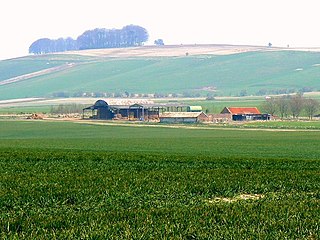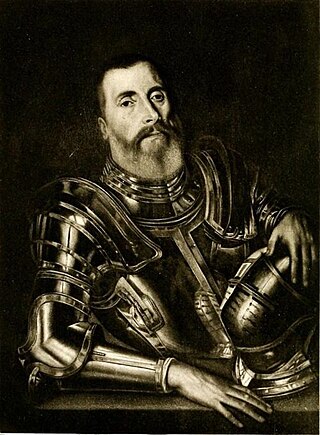Related Research Articles

Berwick Bassett is a small village and civil parish in Wiltshire, England, about 6 miles (10 km) northwest of Marlborough and 8 miles (13 km) southwest of Swindon. The village is on the west bank of a headstream of the River Kennet and close to the A4361 road, formerly the A361, which links Devizes and Avebury with Wroughton and Swindon.

Winterbourne Bassett is a small village and civil parish in Wiltshire, England, about 6 miles (10 km) southwest of Swindon and 7 miles (11 km) northwest of Marlborough.

Winterbourne Monkton is a small village and civil parish in Wiltshire, England, about 1 mile (1.6 km) north of Avebury Stone Circle and 6 miles (10 km) northwest of Marlborough.
Sir James Cambell or Campbell was an English merchant who was Lord Mayor of London in 1630.

Breamore House is an Elizabethan manor house noted for its fine collection of paintings and furniture and situated NW of Breamore village, north of Fordingbridge, Hampshire, England. Though it remains in private hands, it is open to visitors from April to October.

Sir William Holles rose from apprenticeship to a mercer to become master warden of his company and Lord Mayor of London in 1539.
Sir Lionel Duckett was one of the merchant adventurers of the City of London. He was four times Master of the Mercers' Company, and Lord Mayor of London in 1572.

Sir William Rowe was an English merchant who served as the Sheriff of London in 1583 and Lord Mayor of London in 1592. He was Master of the Worshipful Company of Ironmongers and was knighted 1593. He died on 23 October 1593. Sir William's cousin Sir Thomas Rowe was also Lord Mayor of London, in 1568, as was Sir Thomas's son Henry Rowe in 1607.

Thomas Smythe or Smith of London, Ashford and Westenhanger, Kent was the collector of customs duties in London during the Tudor period, and a member of parliament for five English constituencies. His son and namesake, Sir Thomas Smythe, was the first governor of the East India Company, treasurer of the Virginia Company, and an active supporter of the Virginia colony.

Note : dates are given using the New Style calendar.

Sir Edward Osborne (1530?–1591), was one of the principal merchants of London in the later sixteenth century, and Lord Mayor of London in 1583.
Sir John Garrard, sometimes spelled Gerrard, was a merchant and alderman of the City of London, six times Master of the Worshipful Company of Haberdashers, a Buckinghamshire landowner, and Lord Mayor of London for the year 1601 to 1602.
Sir Christopher Clitherow was an English merchant and politician who sat in the House of Commons from 1628 to 1629. He was Lord Mayor of London in 1635.
Sir Sebastian Harvey was an English merchant who was Lord Mayor of London in 1618.
John Nicholl F.S.A. (1790–1871) was an English antiquary.
John Maxwell, 8th Lord Maxwell was a Scottish Catholic nobleman. In 1581 he was created Earl of Morton, and in 1587 he travelled to Spain where he took part in the planning of the Spanish Armada.
Nicholas Mynn, of Little Walsingham, Norfolk, was an English politician.

Sir William Humfreys, 1st Baronet, was a British ironmonger and politician who sat in the House of Commons from 1715 to 1722. He was Lord Mayor of London for 1714–15 and a Director of the Bank of England between 1719 and 1730.
Sir Stephen Slaney was an English merchant, four times Master of the Worshipful Company of Skinners, and Alderman, Sheriff and Lord Mayor of London. He has been called "one of the most picturesque of the Elizabethan Merchant Adventurers".
References
- ↑ Collections for a History of Staffordshire, Vol.VII, 1904, p.211
- ↑ Some Account of the Worshipful Company of Ironmongers by John Nicholl p.116
- ↑ Powell, W. R., ed. (1966). "A History of the County of Essex: Volume 5 pp267-281 - Dagenham: Introduction and manors". British History Online. University of London. Retrieved 21 February 2021.
- ↑ Baggs, A. P.; Freeman, Jane; Stevenson, Janet H. (1983). "Parishes: Winterbourne Monkton". In Crowley, D. A. (ed.). A History of the County of Wiltshire, Volume 12. University of London. pp. 192–198. Retrieved 20 February 2021– via British History Online.
- ↑ "Genealogical History Of Hudson And Bergen Counties New Jersey - CORNELIUS BURNHAM HARVEY". JerseyCityHistory.com. Retrieved 21 February 2021.
- ↑ A Brief History of the Worshipful Company of Ironmongers, T. C. Noble, p.31
- ↑ Some Account of the Worshipful Company of Ironmongers, John Nicholl, p.548